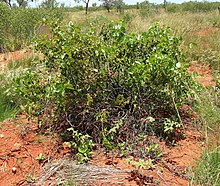| Ipomoea costata | |
|---|---|

| |
| Scientific classification | |
| Kingdom: | Plantae |
| Clade: | Tracheophytes |
| Clade: | Angiosperms |
| Clade: | Eudicots |
| Clade: | Asterids |
| Order: | Solanales |
| Family: | Convolvulaceae |
| Genus: | Ipomoea |
| Species: | I. costata
|
| Binomial name | |
| Ipomoea costata | |
Ipomoea costata, commonly known as rock morning glory, is an Australian native plant.[2] It is found in northern Australia, from Western Australia, through the Northern Territory, to Queensland.[3] Its tubers provide a form of bush tucker to some Aboriginal peoples, known as bush potato,[4] or (to the Ngururrpa groups in WA), karnti.[5]
Description
[edit]It is a prostrate or climbing perennial growing up to 3 m high, with purple-blue-pink flowers from February to November.[2] Juvenile form is a vine, maturing into a woody-stemmed shrub with vine-like stems. Leaves are broad and leathery, 4-9 cm long.[4] Tubers are rounded, 12-20 cm long by 5-18 cm wide, with a single plant potentially having up to twenty tubers.[6]
Habitat
[edit]It occurs on sandy or rocky soils, often over limestone,[2] and on spinifex sand plains in northern Australia.[4]
Uses
[edit]It is the source of bush potato, a bush tucker food for Aboriginal people.[4] Bush potatoes are cooked on the warm earth under coals, and are peeled when cooked.[6]
Aboriginal names
[edit]In Central Australia, I. costata is also known to Aboriginal people by the following names:[7]
- Alyawarr: anaty
- Anmatyerr: anaty or anek
- Eastern Arrernte: anatye
- Western Arrernte: natye
- Pintupi: ala or yala
- Warlpiri: karnti or paparda
References
[edit]- ^ "Ipomoea costata". Australian Plant Census. Retrieved 16 February 2021.
- ^ a b c Grazyna Paczkowska (8 November 1996). "Ipomoea costata Benth. Rock Morning Glory". FloraBase. Western Australian Herbarium. Retrieved 16 February 2021.
- ^ "Occurrence records". The Australasian Virtual Herbarium (AVH). Atlas of Living Australia. Retrieved 16 February 2021.
- ^ a b c d Low, Tim (1991). Wild Food Plants of Australia. Angus & Robertson. p. 163. ISBN 0207169306.
- ^ "New Ngururrpa Indigenous Protected Area". Country Needs People. 1 August 2018. Retrieved 14 May 2021.
- ^ a b Isaacs, Jennifer (1991). Bush Food: Aboriginal food and herbal medicine. Ure Smith Press. p. 94. ISBN 0725408340.
- ^ Vincent, Ange (July 2009). "Australian Bush Foods Information Sheet 6: Bush Potato Ipomoea costata & I polpha" (PDF). Desert Knowledge CRC. Retrieved 18 March 2020.
External links
[edit]
Well, that’s interesting to know that Psilotum nudum are known as whisk ferns. Psilotum nudum is the commoner species of the two. While the P. flaccidum is a rare species and is found in the tropical islands. Both the species are usually epiphytic in habit and grow upon tree ferns. These species may also be terrestrial and grow in humus or in the crevices of the rocks.
View the detailed Guide of Psilotum nudum: Detailed Study Of Psilotum Nudum (Whisk Fern), Classification, Anatomy, Reproduction